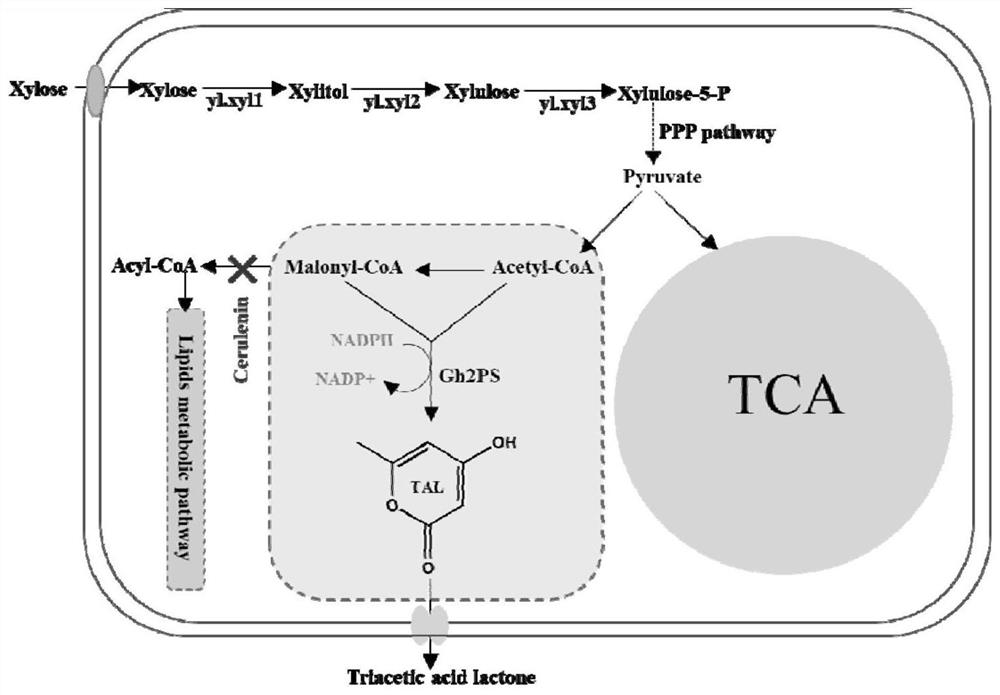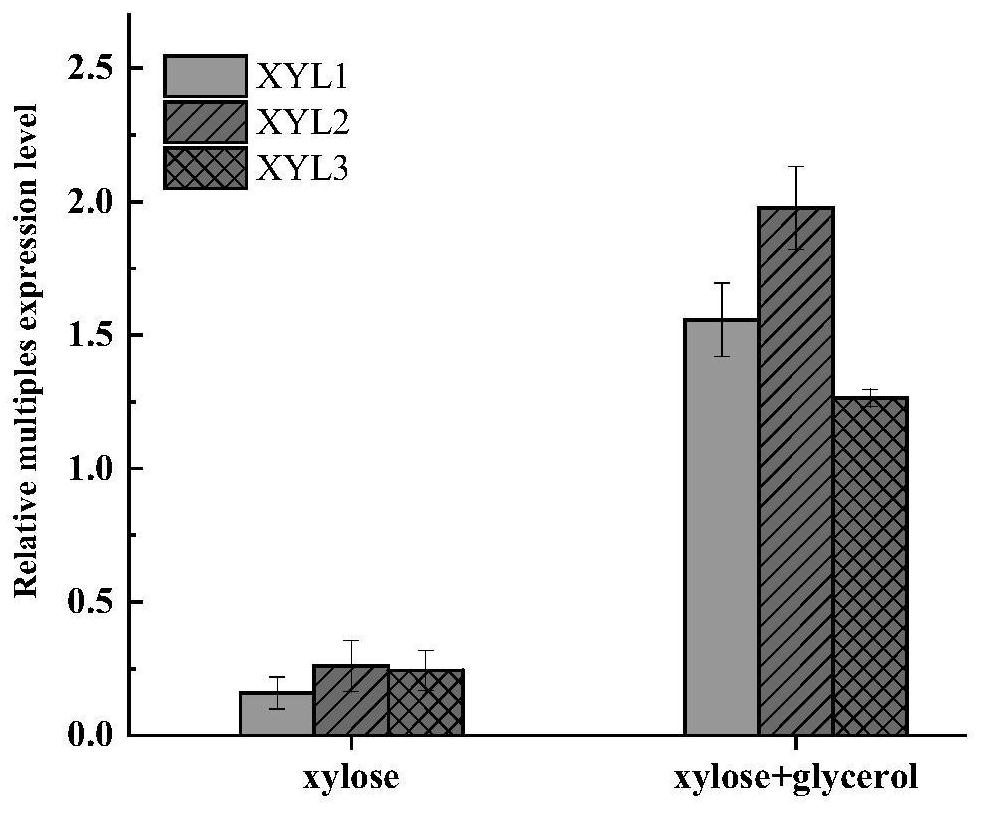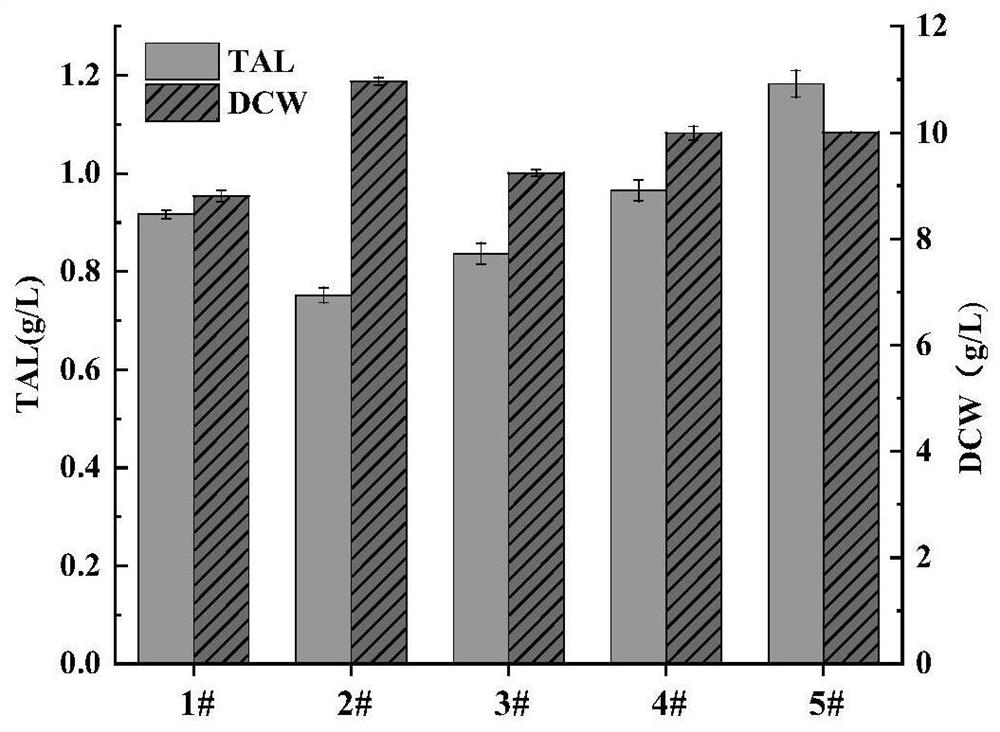Yarrowia lipolytica engineering bacterium for producing triacetate lactone by using xylose and application of yarrowia lipolytica engineering bacterium
A technology of Yarrowia lipolytica and engineering bacteria, applied in application, genetic engineering, fermentation and other directions, to achieve the effect of optimizing the fermentation process
- Summary
- Abstract
- Description
- Claims
- Application Information
AI Technical Summary
Problems solved by technology
Method used
Image
Examples
Embodiment 1
[0043] Embodiment 1: Mechanism research based on glycerol as xylose metabolism "response switch"
[0044]In order to explore the regulatory mechanism of glycerol in the process of xylose metabolism in Yarrowia lipolytica, Yarrowia lipolytica po1f containing the empty plasmid PYLXP' was cultured in a leucine-deficient xylose fermentation medium (xylose 40g / L , YNB1.7g / L, ammonium sulfate 1.1g / L, CSM-Leu 0.69g / L, the rest is water) in a 250mL shake flask, add 3‰ pure glycerol at the same time, 30℃, 250rmp / min, culture to logarithm The bacteria were extracted during the growth period, and qPCR was used to determine the intracellular xylose reductase gene yl.xyl1, xylitol dehydrogenase gene yl.xyl2, xylitol dehydrogenase gene yl.xyl2, Expression level of xylulokinase gene yl.xyl3.
[0045] β-actin was selected as an internal reference gene, and the relative mRNA expression levels of these three genes were determined. See the test results figure 2 , showing that compared with t...
Embodiment 2
[0048] Example 2: Construction of a synthetic pathway for producing triacetolactone from xylose
[0049] In order to further enhance the ability of Yarrowia lipolytica to metabolize xylose to produce high-value chemical triacetolactone, the optimized 2-pyrone synthase gene gh2ps and xylose reductase gene yl were introduced into Yarrowia lipolytica po1f .xyl1, xylitol dehydrogenase gene yl.xyl2, and xylulokinase gene yl.xyl3 expression cassettes to obtain Yarrowia lipolytica recombinant strain Yali01, the gene sequence of which is shown in SEQ ID NO.1 to SEQ ID NO.4 Show.
[0050] (1) Plasmid construction
[0051] The optimized gh2ps gene is synthesized by the company, and yl.xyl1, yl.xyl2, and yl.xyl3 are all from the Yarrowia lipolytica po1f genome. Amplified with gh2ps-F / gh2ps-R, yl.xyl1-F / yl.xyl1-R, yl.xyl2-F / yl.xyl2-R, yl.xyl3-F / yl.xyl3-R as primers respectively Optimized nucleotide sequences gh2ps (SEQ ID NO.1), yl.xyl1 (SEQ ID NO.2), yl.xyl2 (SEQ ID NO.3) yl.xyl3 gene...
Embodiment 3
[0067] Embodiment 3: Yarrowia lipolytica recombinant strain Yali01 fermentation produces triacetin
[0068] (1) Culture of recombinant bacteria
[0069] First, the recombinant bacterium Yali01 obtained in Example 2 was connected to 3mL leucine-deficient seed medium (xylose 20g / L; YNB1.7g / L; ammonium sulfate 5g / L; CSM-Leu0.69g / L, The rest is water.) in a test tube at 30°C, cultivated in a shaker at 250rpm for 2-3 days, inoculated into a 250mL Erlenmeyer flask containing 30mL of leucine-deficient fermentation medium by 2% inoculum size, and placed in a shaker Cultured in Li for 7 days, the shaker conditions were set at 30°C, 250rpm, and samples were taken for analysis every 24h.
[0070] The components and contents of the fermentation medium are as follows: 40g / L xylose, 1.7g / L YNB, 1.1g / L ammonium sulfate, 0.69g / LCSM-LEU, 3g / L glycerol, and the rest is water.
[0071] (2) Detection of fermentation broth
[0072] Use a microplate reader or a UV spectrophotometer to measure th...
PUM
 Login to View More
Login to View More Abstract
Description
Claims
Application Information
 Login to View More
Login to View More - R&D
- Intellectual Property
- Life Sciences
- Materials
- Tech Scout
- Unparalleled Data Quality
- Higher Quality Content
- 60% Fewer Hallucinations
Browse by: Latest US Patents, China's latest patents, Technical Efficacy Thesaurus, Application Domain, Technology Topic, Popular Technical Reports.
© 2025 PatSnap. All rights reserved.Legal|Privacy policy|Modern Slavery Act Transparency Statement|Sitemap|About US| Contact US: help@patsnap.com



